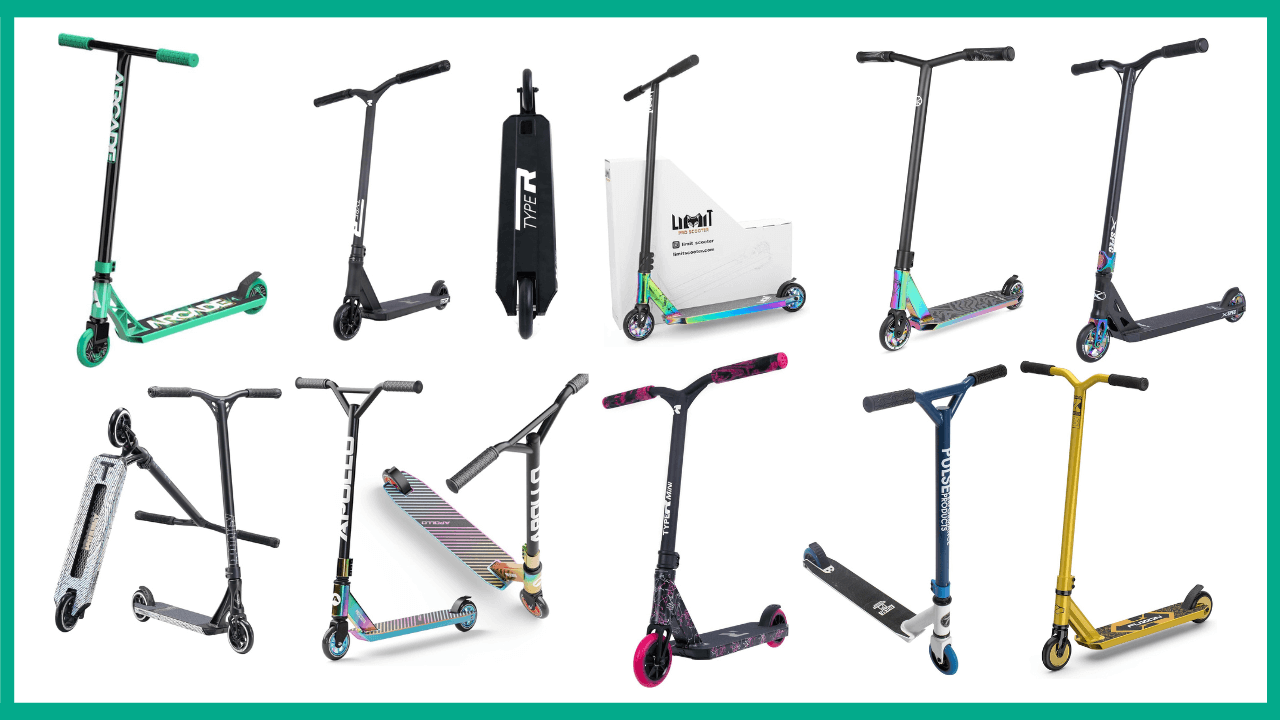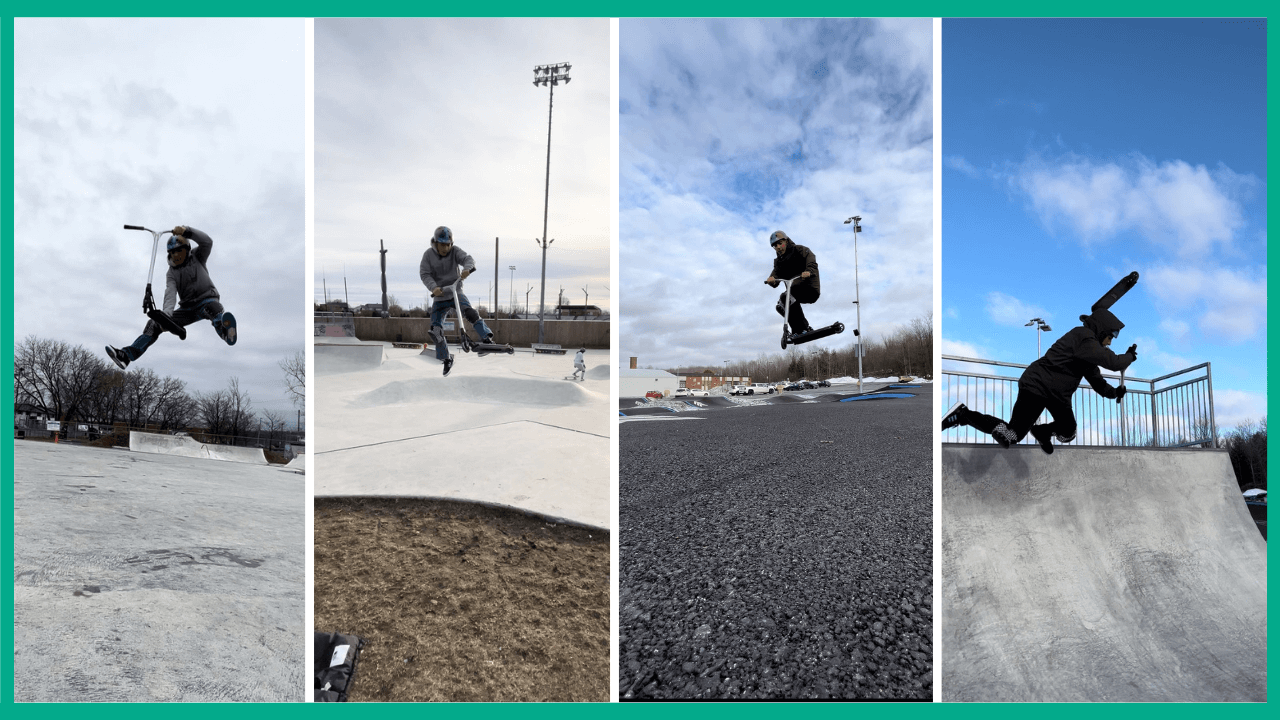It is undeniable that riding a freestyle scooter is fun and exciting for people of all skill levels, from complete beginners to average riders and experts.
Table Of Contents
ToggleOne of the most exciting thrills for scooter riders is adventuring stances on a freestyle scooter. My best friend Albert is one of them, always trying new tricks to impress his girlfriend. As I am experienced in this regard, I always try to assist him.
Then, I wanted to share the learnings with the enthusiastic freestyle scooter riders for the most precise understanding.
If you want to learn more about freestyle scootering or are just starting, this guide will help you get around just like Albert.

What Type Of Freestyle Scooter Is The Best To Start As A Beginner?
Choosing a model that is both cheap and long-lasting is a good idea. Brands like-
Fuzion and ARCADE offer great entry-level scooters that will stay within your budget. These scooters are built to survive the expected bumps and falls you might experience as a beginner.
Consider the Rocket R1 or the ProRide Street Blazer for an excellent start. These bikes feature durable designs without losing quality. Rocket Scooters, in particular, offer a great mix of affordability and sturdiness, making them an ideal choice for those testing the freestyle scooter seas.
Once you’ve learned the basics and decided to level up, you can dive into the more complex features and designs.
Freestyle Scooter Tips For Beginners
As a beginner or novice rider, you might be looking for how to start your riding. Then, you can follow the given steps to be a potential freestyle scooter rider.
Step 1: Choose The Scooter
For beginners, the first step is to choose the right scooter to practice freestyle stances. You must look for a model that suits your height, weight, and riding style.
Entry-level scooters are designed with durability and stability, making them perfect for those just getting the hang of things.
Step 2: Be Familiar With Components
Once you have your scooter, you must get familiar with the essential components, including the deck, handlebars, wheels, and brakes.
Step 3: Keep Practicing
The most important part is to practice more and more. At your very first beginning, you should focus on developing a solid foundation of balance and control. Spend time practicing simple maneuvers like riding in a straight line, turning, and stopping.
This will help you build confidence and improve your overall stability on the scooter.
Step 4: Introduce The Tricks
Gradually introduce basic tricks and manuals to enhance your skills as you become more comfortable. As a novice, try to be proficient in the basics first.
Step 5: Know The Risk And Be Confident
There is a high risk of slipping, getting injured, and even a risk of bone fracture. While practicing, be skilled enough to be confident. The more you own the process of freestyle scootering, the more you learn and be a pro-level rider.
If you still need to start, then begin now and give a start to your riding potential and interest.
What Are The Basic Tricks A Beginner Should Learn?
A beginner should learn and have the basics of freestyle scootering. Try these styles to be advanced.
Tailwhip
A tailwhip is a trick where the rider kicks the deck (the flat part of the scooter) with one foot,
causing it to spin around the handlebars while the rider remains on the scooter. The trick involves the scooter rotating horizontally around the vertical axis.
Learning a tailwhip helps beginners develop balance and coordination. Kicking the deck and controlling the spin teaches riders to maintain equilibrium while executing complex movements.
360 Rotation
A 360 Rotation, often referred to simply as a “360” or “full spin,” involves the rider spinning their scooter 360 degrees horizontally while in the air. @AThis trick requires reasonable control and spatial awareness to execute a whole spin and land smoothly.
Beginners learn to gauge distance and timing, improving their ability to control the scooter’s rotation in the air and accurately land the trick.
Barspin
A Barspin is a trick where the rider spins the scooter’s handlebars horizontally while in the air, typically with one or both hands.
The trick involves letting go of the handlebars, spinning them around, and grabbing them again before landing. Barspins require good hand-eye coordination.
As a beginner, you can develop precision in releasing and grabbing the handlebars, enhancing your overall control and confidence in handling the scooter.
Bunny Up
A Bunny Up is a fundamental trick where the rider uses their legs to lift the front or rear of the scooter off the ground, hopping into the air without performing a full jump or trick.
This motion resembles a bunny hop on a traditional BMX or mountain bike. It helps beginners to lift the scooter off the ground, setting the stage for more advanced tricks. It also improves leg strength and control.
For novice freestyle scooter enthusiasts, mastering these fundamental tricks is crucial to building a solid foundation.
How Can I Improve My Balance And Control On The Scooter?
Practice consistently with basic movements like bunny hops and manuals to increase your balance and control on a scooter. Focus on how your body moves when riding and attempt activities that improve your belly muscles.
Get acquainted with controlling your scooter and try riding on various terrains. Use a scooter with a little more oversized deck for better stability. Begin with easy tricks, take your time, and eventually move on to more hard ones. Remember, improvement comes step by step, so be patient and celebrate your success as you grow more competent in operating your scooter.
Is There A Freestyle Scooter Community Or Support Group?
Yes, there is a vibrant freestyle scooter community with numerous support groups, forums, and online platforms where riders can connect, share experiences, and seek advice. Social media platforms such as Instagram, Facebook, and YouTube have dedicated communities and pages where riders showcase their skills, discuss tricks, and offer tips to fellow enthusiasts.
Additionally, various online forums and websites focus specifically on freestyle scootering, providing a space for riders to ask questions, share insights, and connect with the global scooter community. These platforms often include sections for riders of all skill levels, making them accessible for beginners seeking guidance. You can follow Electric Scooter X’s Instagram profile, having almost 9000 followers related to stunt and electric scooters.
How Do You Become A Pro Freestyle Scooter Rider From An Average One?
To be a freestyle scooter rider, be passionate about this. The intention of riding like a professional rider should be to express your skill and talents, not just to impress your lover like my friend Albert. I will suggest some tips to help you out.
Get the Scooter Basics Down
First, make sure you’re best buddies with your scooter. Master simple moves like hopping around and balancing. It’s like learning to walk before you run!
Level Up with Cooler Tricks
Believe you can be a scooting champ; spice things up with fancier moves. Try spinning the handlebars, doing spins in the air, and kicking the scooter around like a pro.
Practice, Practice, Practice
Like anything cool, getting awesome at scootering takes practice. Regularly spend time doing tricks and flips. The more you do, the more you’ll glow on your scooter.
Show Off at Local Scooter Showdowns
Get in on local scooter contests. It’s not just about winning but meeting other scooter pals and getting tips from the pros hanging around.
Find Your Style
Everyone’s got their style. Find yours! Make it uniquely yours, whether how you do tricks or your overall vibe on the scooter.
Post Your Scooter Adventures
Share your scooter journey on social media. Videos, pictures, whatever! It’s like shouting from the scooter rooftops; people might start noticing.
Ask Scooter Companies to Be Your Buddies
Once you’re turning heads, shoot your shot with scooter brands. Tell them about your scooter adventures, and they may want to be part of your scooting story.
Scoot to Bigger Competitions
Take your scooter show on the road! Compete in more significant contests and travel to new places. It’s like going on a scooting adventure!
Be a Super Cool Scooter Pro
Remember to be cool about it as you rise in the scooter ranks. Stay positive and dedicated, and people will notice. That’s how you become a true scooter superhero.
Stay in the Scooter Loop
Scootering is constantly changing. Keep an eye out for new tricks and trends. Being a trendsetter is like being the superhero of the scooter world!
Freestyle scootering is all about having fun. So, enjoy the ride, try crazy things, and be the scooter rockstar you were born to be!
How Can I Improve My Technique And Learn New Tricks?
A significant part is improving the things you have learned, which you must recognize. Following the given steps might be a good help.
Practice Regularly: Consistent practice is the key to improvement. Spend dedicated time each day or week practicing different aspects of scooting, including basic maneuvers and advanced tricks.
Master the Basics: Ensure you have a strong foundation by mastering fundamental skills like balance, turning, and hopping. These essential skills provide the building blocks for more advanced moves.
Set Goals: Establish specific, achievable goals for your scooting. Whether mastering a new trick or increasing the height of your jumps, having goals will keep you motivated and focused.
Learn New Tricks Gradually: Progress to more advanced tricks gradually. Take your time with complex maneuvers before mastering the basics. Build your skills step by step to reduce the risk of injury and enhance overall proficiency.
Watch and Learn from Others: Watch videos of experienced riders to observe their techniques and style. Learning from others can provide valuable insights and inspiration for improving your skills.
Seek Feedback: Ride with more experienced scooters or ask for feedback from riders who have mastered certain tricks. Constructive feedback can help you identify areas for improvement.
Experiment and Innovate: Once comfortable with basic tricks, experiment with variations and add flair. Creativity and innovation will set you apart and keep the sport exciting.
Improve Physical Fitness: Strengthen your core and leg muscles and improve flexibility. Physical fitness contributes to better control, stability, and endurance while scooting.
Take Breaks and Rest: Give your body time to recover. Frequent practice is essential, but so is rest. Allow your muscles and joints time to recover to prevent burnout and reduce the risk of injuries.
Join Scooting Communities: Connect with other scooters through local clubs, online forums, or social media groups. Sharing experiences and tips with fellow riders can provide motivation and new ideas.
Stay Positive and Patient: Improvement takes time, and setbacks are a natural part of learning. Stay positive, be patient, and celebrate small victories along the way.
Record and Analyze: Record videos of your scooting sessions and review them. Analyzing your performance can help you identify areas for improvement and track your progress over time.
By incorporating these tips into your scooting routine, you’ll steadily enhance your skills and enjoy the process of continuous improvement.
What Type Of Protection Should I Use When Performing Tricks?
Ensuring your safety is crucial while executing stunts on a scooter. Here’s an overview of vital protective items to limit the chance of injuries:
- Helmet: A properly fitted helmet is non-negotiable. It protects your head in case of falls or accidents, lowering the chance of catastrophic harm. Look for helmets built exclusively for action sports and check for safety regulations.
- Knee Pads: Knee pads offer vital protection for your knees, which might be susceptible to injury during falls or while performing tricks. Look for knee pads that are sturdy, comfortable, and capable of absorbing impact.
- Elbow Pads: Elbow pads protect your elbows from scratches and collisions. They are especially crucial when trying stunts that entail balance or when there’s a possibility of crashing into your elbows.
- Wrist Guards: Wrist guards assist avoid wrist injuries during falls or while attempting to halt a fall. They support and stabilize your wrists, lowering the chance of sprains or fractures.
- Gloves: Consider wearing gloves to protect your hands from abrasions, mainly if using them to break falls. Look for gloves with reinforced palms for extra durability.
- Shoes with Grip: Wear solid, supportive shoes with excellent traction to maximize your control over the scooter. Proper footwear may minimize slides and give stability while landing stunts.
- Mouthguard: While not always essential, a mouthguard helps protect your teeth and jaw during sudden falls. This is especially crucial for riders trying more complex maneuvers with more considerable collision risks.
Always purchase high-quality, well-fitted safety gear, and ensure it is worn appropriately every time you ride. Prioritize safety, and enjoy your freestyle scootering adventure with confidence.
Where Can I Find A Safe Place To Practice?
Freestyle scootering is safe to practice in designated skateparks, outdoor recreation areas, schoolyards, parking lots during off-peak hours, community centers with outdoor areas, nearby trails or bike paths, deserted tennis or basketball courts, low-traffic residential cul-de-sacs, and occasionally abandoned warehouses or industrial areas.
Always emphasize safety, respect local norms, and confirm your site authorization. Wear safety gear and enjoy your practice in a controlled atmosphere.
Different Skateparks For Freestyle Scootering
As a freestyle scooter rider, you should know about the various scootering skateparks to get more clearance and connectivity to become a great rider. The skateparks of wood, metal, and cement are prominent.
Wooden Skateparks
Wooden skateparks are famous for their versatility and adaptability. It is constructed with plywood wooden ramps, and features offer riders a smooth and forgiving surface. They are often preferred for temporary or mobile skateparks due to their ease of assembly and disassembly.
Wooden skateparks provide a dynamic riding experience, allowing skaters and scooter riders to explore x transitions and obstacles.
Metal Skateparks
Metal skateparks are known for their durability and resistance to weather elements. Typically made of steel or aluminum, metal ramps, and structures are suitable for outdoor installations as they withstand exposure to rain and sunlight.
It often features ramps with adjustable heights, allowing riders to customize their experience. The metallic surfaces offer a slick and fast ride, enhancing the speed and flow of tricks.
Concrete Skateparks
Concrete skateparks are favored for their longevity and solid construction. Designed with reinforced concrete, these parks are permanent community fixtures, providing a stable and robust platform for skaters and scooter riders. Concrete parks often feature bowls, banks, and ledges with smooth surfaces, allowing riders to execute tricks with precision. The natural weather resistance of concrete makes it an ideal material for skateparks designed for long-term use.
You can also read: Best Stunt Scooters That You Can Buy In 2024
Conclusion
Finally, to become a professional and dedicated freestyle scooter rider, you must love learning, be a great observer, and watch the other riders who do better than you.I hope I helped you with this comprehensive guide like I helped my friend Albert, and now he is improving in his scooting journey and impressing his girlfriend!
As you progress on your freestyle scooter journey, remember that everyone’s learning curve is different. Celebrate small victories, stay patient, and enjoy the process of discovering new tricks and pushing your limits. Freestyle scootering is not just a sport; it’s a creative expression that allows riders of all levels to explore their style and blast on two wheels.







